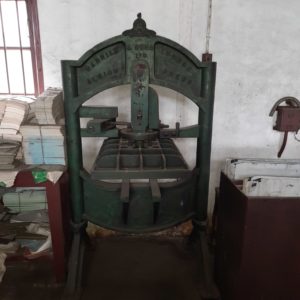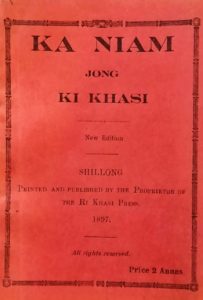Babu Jeebon Roy (1838-1903) was born in Saitsohpen, Sohra, then headquarters of the English East India Company for the Khasi Agency. Born to U Ram Sing Jaid Rani and his second wife, Ka Bijan Laitkynsew Jaid Mairom, his childhood sowed the roots of social reform. He had a brother, Bon Roy and a sister, Tiewbon.
There was no formal education in the hills then. Roy, ever so hungry to get knowledge was tutored at home. Credit must go to Ram Sing; he understood the importance of education, having studied at the Mission School at Serampore (Calcutta).
Remaining confined in one school of thought was never Jeebon Roy’s mission – he entered Government service, working as a writer and interpreter for General Showers, during the Jaintia Rebellion in 1860. His approach earned the respect of his superiors. He became the Senior Extra Assistant Commissioner.
Roy retired from service in 1894.

Educationist
He understood the importance of literacy and corresponded with the British authorities for this purpose in 1875. Initially, they were dismissive but he did not give up and established the Zillah School, which was inaugurated on September 2, 1878. He paid Rs 900 from his own pocket.
Perhaps, the British hoped it would be a failure, but the response was enthusiastic. Fifty pupils joined the school. This made T. Jerman Jones, the Education Officer, take note of this development – he had plans to merge the Mission Minor School with Zillah School. Later, this school would be known as Shillong Government High School in Mawkhar.
The first headmaster of the school was R. Mohan Mitra and the first Khasi student to pass out of this school was Roy’s eldest son, Sib Charan Roy. “This school became the doorway to higher education in the Khasi and Jaintia Hills,” his great granddaughter and author Bijoya Sawian said.
The Vision
Babu Jeebon Roy established the first vernacular press, the Ri Khasi Press in the Khasi Hills in 1896.
He believed that modernity was rooted in education; in civil society, that would be the greatest contribution for a community. At the same time, he realised how the stress was on the publication of Biblical stories along with translations of the Bible.
This propelled him to establish a press that would go beyond religion and focus on literacy. He wrote to the government for permission. They agreed and he established the Press in the compound of his residence in Umsohsun, with his own earnings. The first manager of the press was his son, Babu Chandranath Roy.
He noted how educated Khasi girls hesitated to take up unconventional jobs. The political thinker and activist, Rev J.J.M. Nichols Roy (1884-1959) noticed this and wrote, “I have seen Babu Jeebon Roy employing his own daughter in the Ri Khasi Press. In those times, respectable Khasi girls were ashamed to take up such employment. This gentleman has led the way in the manner which nobody has ever thought of before.”

The printing press also functioned as a Training School right from its inception. Apprentices were taught the art of printing gratis and given a small allowance for their maintenance – a feature that was maintained till the 1940s.
Different Streams of Thought
Babu Jeebon Roy shared Shri Aurobindo’s belief that real education “shaped the inner sensibilities of a child and lead the path to mental, intellectual, spiritual and emotional development”. Education, thus, was not just about material prosperity.
He wrote books in simple language which were full of moral values. From 1897 to 1901, Roy published a wide-ranging variety of books. Some of the important publications in this regard were – Ka Niam Jong Ki Khasi (1897); Ka Kot Pule Khasi Nyngkong (Khasi reader, published in 1899); Ka Kitab Shaphang Uwei U Blei (1900), and Ka Jingsneng Tymmen (written by Radhon Singh Berry), the Khasi book on Ethics and Etiquette (1901), among others.
Roy saw the importance of being connected with the rest of India and the publications were not just limited to concerns of North East India, as can be seen through the Khasi translations of the Hitopadesha (1898), Ramayana and Chaitanya Charittra (1900) and Buddha Deb Charitrra (1901). Sib Charan Roy, translated the Bhagavad Gita.
In the preface of the translation of Hitopadesha, he wrote: “I have rendered these into Khasi because I want you to get acquainted with such great literature so that you may learn and understand Sanskrit as well as Bengali… I want you to read these classics for enlightenment and for you to be informed.”

Along with these, the Press also published Khasi books of the alphabet punctuation, numbers, History, religion and readers for children. Roy was also a translator and, like his father, was well-versed in Sanskrit and Bengali.
Periodicals and Newspapers
Some of the monthly journals were – U Khasi Mynta, first printed on March 7, 1896 at the Assam Advertiser Press, Shillong, Assam (published by Agnes M. James). The printing of this journal was later shifted to Ri Khasi Press on January 1st, 1897; Ka Pateng Khristan, first published in April 1900; and U Nongialam Khristan, first printed in July 1902. The editors were Reverends – J. Roberts and J.C. Evans – and published by the Welsh Mission.
Among Khasi weekly publications, mention must be made of Apphira (1990-91); Surphira (1991-92); and U Lum Shillong (1991). Two English weeklies were Newsline, published from 1990 till 1995, and Business Chronicle (1994-99). Some of the notable dailies were – Rupang (1991-95); Mawphor (1991-94); U Peitngor (1991-95) and U Nongsain Hima (1992-95).
It is important to note that Rupang, Mawphor and U Nongsain Hima have established their own printing press.
Then and Now
In the late 1800s and early 1900s, the machines used were basic manual hand press machine, imported from England via the agents in Calcutta. Mechanical machines were introduced in the early 1900s; however, the composition was still manually done.

In the mid-1900s, hot metal composition and larger semi-automatic machines were brought in. In the mid-1970s, a fully automatic letterpress machine was introduced. From 1989 onwards, offset lithographic printing and computerised composition followed.
At present, the Ri Khasi Press has the modern machine, using the latest printing technology.
Missionaries, Seng Khasi, Brahmo Movement and Unitarianism
Babu Jeebon Roy and the missionaries respected each other but differed on religion. Even though he respected all faiths, Roy feared that a cultural vacuum would lead to a loss of identity.
The Seng Khasi was formed in 1899, an organization with a specific purpose – preservation of the Khasi culture and faith, Niam Khasi. They were inspired by Roy.
The preface of Bijoya Sawian’s English translation of The Book About One God mentions the names of Rev Nilmani Chakravarti, Babu Sadaya Charan Das and Radhon Sing Berry – men connected with the Brahmo Samaj Movement in the Khasi Hills – and acknowledged them as friends.

Babu Jeebon Roy and Babu Hajom Kissor Sing knew each other and would debate on important issues of the day. Later, Unitarian icon, Margaret Barr became a close friend to his family.
Memory in Anecdotes
Babu Jeebon Roy steered an important vision – one of co-existence and it formed the philosophy of the “Father of Modern Khasis”. On the 125th anniversary of the Ri Khasi Press, let us remember how a leap of faith ushered in an era of transformation in Khasi society.
Author Bijoya Sawian remembers how the Ri Khasi Press was “a charming Assam-style building, tin-roofed and mostly wood”.
She said, “it got burnt sometime in the 1960s because of a short circuit. I remember that night – the leaping flames, soon after dinner. Most of all, I remember my younger Mama, Kynpham Singh. He was devastated. We were then told of Parad Jeebon Roy’s reaction when the entire town and his house collapsed under the fury of the Great Earthquake of June 12, 1897.”

Sawian added, “He was then the Extra Assistant Commissioner. Apparently, the Deputy Commissioner, Mr Arthbutnot sent his Superintendent Rai Bahadur Sadaya Charan Das to see if all was well with Babu Jeebon Roy and his family. Mr. Das waded through the debris and rubble and reached Umsohsun to find Great-grandfather sitting on a chair, under a makeshift tent with a table in front of him. His entire family was sheltered in the chicken coops. Not much conversation took place. Mr. Das reported back that all was as well, as could be. And on the table in front of Jeebon Roy, he noticed a piece of paper on which two words were written – TRY AGAIN.”
(With inputs from Bijoya Sawian, Wallamphang Roy and the family of Babu Jeebon Roy who shared valuable resources, in writing this piece)



